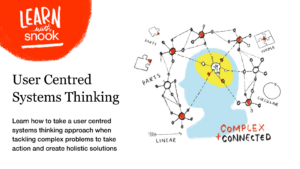About this event
Systems thinking – a holistic problem-solving approach that focuses on understanding the connections of a complex network – is not new. But remarkably it’s rarely used alongside user centred design methods to create holistic solutions.
This course will enable you to take a user centred approach to systems thinking. It will help you adapt and enhance existing design tools to deliver impactful change. You’ll learn how to address the root cause of challenges and future-proof your designs.
Organisations often struggle to make effective change when designing in complex spaces, where every action and decision has a knock-on effect. Problems rarely happen or are solved in isolation. It can mean teams often only see part of the picture when designing solutions, which can result in projects failing or being less impactful.
On the flip side, projects that take an entirely system-based approach can be too high level and strategic, making it difficult to make practical changes at a service level. Teams can end up feeling so overwhelmed by the size of the system and the number of decisions to be made that it’s hard to know where to start.
This course combines user-centred design methods and tools with traditional systems thinking, offering an innovative approach to solving complex problems.
We’ll cover user centred systems theory, with practical examples. You’ll leave the course with the tools and methodology to understand complex systems and deliver well-designed interventions. You’ll learn to make meaningful day-to-day changes while working towards an ideal future.
What you will learn
As designers, the challenges we’re facing are getting increasingly more complex and interconnected. Drawing on Snook’s extensive experience, we’ll share:
- The concepts underpinning user centred systems thinking approach
- How and when to apply a systems approach (and what to watch out for!)
- Common techniques for visualising a system
- How to set boundaries in a system
- How to use insights from user-centred systems thinking to inform decision
Who should go on this course
We’ve designed this course for:
- People who are interested in – but new – to systems thinking
- Established designers who work in complex spaces (in house and in agencies)
- People in strategic roles who want a better understanding of the system around them
Note: We recommend participants have a knowledge of basic design tools, such as journey mapping, service blueprinting, etc.
Find out more about our Journey Mapping & Service Blueprinting course
Why Snook?
For over ten years Snook has been quietly revolutionising the private and the public sector, on a mission to make the world more human. We’ve built great products and services in a wide range of scenarios, putting people at the heart of the design process every time. We want to share what we have learned from these experiences with you so more people can benefit from the value service design brings.
